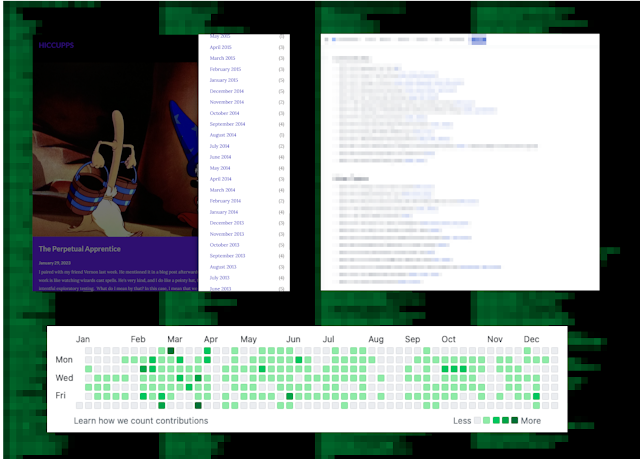A couple of weeks ago I was wondering what testing patina might look like.
What do I mean by patina in this context? I think I'm looking for artefacts and side-effects of work, visible on tools and places of work, that demonstrate something about the length of time, depth, and breadth of work, and ways of working.
I'm seeking things that other practitioners could recognise and appreciate as evidence of that work. But, and this is important, the patina is not the work itself.
So here's the list of things I've come up with so far:
Patina might be visible in an IDE I've been using for a long time through a litter of plug-ins, some for defunct tooling, or obsolete languages, with multiple plug-ins for the same file format, and so on.
Patina might be visible at work from my Confluence home page where I collect links to the internal talks and demos I've done. (Top-right in the image at the top, and deliberately obfuscated I'm afraid.)
Patina might be visible in a recursive listing of my testing notes directory structure, the dates and titles, the clusters of related work in clumps and distributed over time, and so on. (This is the background in the image.)
Patina might be visible in the lengthy blog archive menu right here on Hiccupps. (Top-left.)
Patina might be visible in my Git commit history map and other statistics showing that I'm active in loads of repositories within and outside my team, including repos that I created and are now shared across the company. (The map is on the image, the other data I can't share.)
Patina might also be visible, were anyone to care to extract it, in my Git commit messages. I strive to work in small steps and be informative when I commit.
In the physical realm, patina might be visible on a person's desk. I have had one or two colleagues with truly chaotic desks, covered with movable things (paper, books, etc) that were pieces of work in progress, mostly long since abandoned.
Patina might be visible through a bookshelf of well-thumbed reference books, or a large collection of shabby notebooks. Maybe pages full of numerous tasks crossed
out in different coloured pens, sketches of systems, with overwriting
and annotation is patina too.
Patina could also be visible on a keyboard. Seeing a worn out `:` and `q` could tell other practitioners something about editor usage, for example.
Brian Marick, whose podcast inspired this line of thought, offered a suggestion as well: "the physical layout and decorations of a team room. I think they do have that same air of projecting history and seriousness (and belonging?)"
Got more ideas? I'm keen to hear them.
